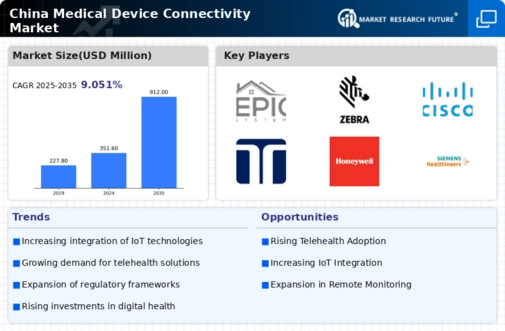Government Initiatives and Support
The Chinese government is actively promoting the development of the medical device-connectivity market through various initiatives and policies. The 'Healthy China 2030' plan emphasizes the importance of digital health technologies, including connected medical devices. This governmental support is likely to foster innovation and investment in the sector, as funding and resources are allocated to enhance healthcare infrastructure. Additionally, the government is encouraging public-private partnerships to facilitate the development of advanced medical technologies. As a result, the medical device-connectivity market is expected to benefit from increased funding, leading to the introduction of new products and services that meet the evolving needs of the healthcare system.
Growing Focus on Chronic Disease Management
Chronic diseases are a significant health concern in China, with conditions such as diabetes and cardiovascular diseases affecting millions. The medical device-connectivity market is responding to this challenge by offering solutions that facilitate better management of chronic conditions. Connected devices enable patients to monitor their health metrics in real-time, providing valuable data to healthcare providers for informed decision-making. The increasing prevalence of chronic diseases is expected to drive the demand for connected medical devices, with projections indicating a market growth of 20% over the next few years. This focus on chronic disease management is likely to enhance the overall efficiency of healthcare delivery in China.
Rising Demand for Remote Patient Monitoring
The medical device-connectivity market in China is experiencing a notable surge in demand for remote patient monitoring solutions. This trend is driven by an increasing aging population, which is projected to reach 400 million by 2040. As healthcare providers seek to enhance patient care while reducing costs, remote monitoring devices are becoming essential. These devices enable continuous health tracking, allowing for timely interventions and improved patient outcomes. The market for remote monitoring devices is expected to grow at a CAGR of 25% over the next five years, indicating a robust expansion in the medical device-connectivity market. Furthermore, the integration of advanced connectivity features in these devices enhances their functionality, making them more appealing to both healthcare providers and patients.
Increased Investment in Digital Health Startups
Investment in digital health startups is on the rise in China, significantly impacting the medical device-connectivity market. Venture capital firms and private investors are increasingly recognizing the potential of connected medical devices to transform healthcare delivery. This influx of capital is fostering innovation and accelerating the development of new technologies that enhance connectivity and data sharing among medical devices. As startups introduce novel solutions, the competitive landscape of the medical device-connectivity market is evolving, leading to improved offerings for healthcare providers. The trend of increased investment is expected to continue, further propelling the growth of the medical device-connectivity market in the coming years.
Technological Advancements in Connectivity Solutions
Technological advancements are playing a crucial role in shaping the medical device-connectivity market in China. Innovations in wireless communication technologies, such as 5G, are enhancing the capabilities of connected medical devices. These advancements allow for faster data transmission and improved reliability, which are essential for real-time monitoring and telehealth applications. The integration of artificial intelligence and machine learning into medical devices is also transforming the landscape, enabling predictive analytics and personalized healthcare solutions. As these technologies continue to evolve, they are likely to drive further growth in the medical device-connectivity market, with an anticipated increase in device adoption rates among healthcare providers.

















Leave a Comment